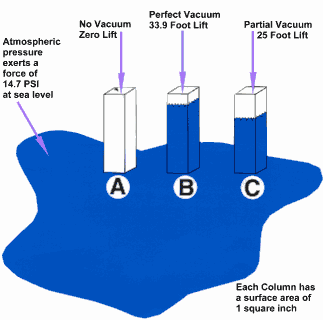|
It is common for customers to say that they need a pump to suck water out of a hole or trench. However, centrifugal and diaphragm pumps do not actually suck water so much as they raise or lift it with help from mother nature. Water, like electricity, will always flow along the path of least resistance. In order to lift water the pump must provide a path (area of low pressure or low resistance) to which the water will naturally seek to flow. It is critical then to recognize the role atmospheric pressure plays in creating such lift. At sea level the atmosphere exerts a force of 14.7 lb/in2 (PSI) on the earth's surface. The weight of the atmosphere on a body of water will prevent lift from occuring unless an area of low pressure is created.  The above figure shows three hollow tubes, each with a surface area of 1 square inch, rising from sea level up into the atmosphere. In tube (A) atmospheric pressure is the same inside the tube as it is outside: 14.7 PSI. Since the weight of the atmosphere is being exerted equally across the surface, no change occurs in the water level inside the tube. In tube (B) a perfect vacuum is created making atmospheric pressure greater on the water outside the tube. The resulting differential causes water, flowing naturally to the area of lowest pressure to begin filling the tube until it reaches a height of 33.9 feet. Why is 33.9 feet the highest water can be lifted in this example? Because at this point the weight of the water inside the tube exerts a pressure equal to the weight of the atmosphere pusing down on the ocean's surface. This height represents the maximum Divide atmospheric pressure at sea level by 0.0361 lb/in3 (the weight of one cubic inch of water) to obtain the theoretical suction lift. 14.7 (lb/in2) / 0.0361 (lb/in3) = 407.28 (inches) 407.28 (inches) / 12 (inches per foot) = 33.9 (ft) Remember that 33.9 feet is the maximum theoretical height water can be lifted under perfect conditions at sea level. It does not take into consideration altitude, friction loss, temperature, suspended particles or the inability to create a perfect vacuum. All these variables affect pump performance and reduce theoretical suction lift. the practical suction lift, attainable for cold water (60oF) at sea level by creating a partial vacuum, is the 25 feet reflected in tube (C). |
